From the KHORS-statutes
The KHORS statutes were not written anywhere, and they were never approved by anyone. KHORS has never had a constituent assembly, held any meetings, or remembered the date of its birth.
The basic law of KHORS: the primacy of artistic form. Any artist – regardless of race, nationality, confessional or political convictions – who recognizes this basic law may belong to the KHORS. (Communists are automatically excluded because, apart from countless intellectual crimes, their ideology does not recognize the primacy of form).
Anyone who joins the group “The KHORS Family” can make this known to the KHORS headquarters, whose location is changeable at any time but does not necessarily have to do so – either when joining or when leaving. (You can leave the “KHORS family” at any time without giving reasons). It is enough for the “KHORS family” for someone to realize that they belong to it. If he is not a master of complete form, this deception of KHORS remains exclusively on the personal conscience of such an artist.
KHORS disseminates its artistic ideas and the fruits of its creative activity by all means at its disposal.
KHORS addresses only the personalities. KHORS rejoices in all its followers, whether they number in the tens or thousands: quantity is irrelevant, and the principle of mass appeal is firmly and uncompromisingly rejected by KHORS.
KHORS is in favor of complete independence in the evaluation of artistic phenomena. “KHORS approves,” “KHORS recommends,” “KHORS protests” – this concerns only those choristers who are involved in the KHORS issue in question, without other choristers being obliged to do anything. Several groups of KHORS supporters can emerge with independent thoughts, programs, and tasks. For example, a group of Japanese choristers aiming at the Europeanization of domestic poetry or a group of French choristers with the purpose of propagating the art of Marc Chagall in the textile industry.
Every new style emerges by chance, i.e. through the higher law of creative forces embodied in a strong artistic personality. The last new style in time was Surrealism, and KHORS has nothing new after that in the depths of his movement to propose to the world. But in every epoch, there must be someone who keeps the fire in the hearth of art: the cultivation of pure form. This cultivation of form, which the everlasting Philistine – the Eternal Philistine – regards as a wild “novelty” or as a “ causeless repetition of already outlived caprices”, is in fact only the simple fidelity of pure artists to pure art – the Eternal Art Tradition. KHORS took on this modest role unconditionally, and all choristers are united in it – despite individual differences in conviction and evaluation. It guarantees the existence of the KHORS – the Eternal KHORS – without statutes, meetings, conventions, and without a precise list of members.
In original German
Aus den CHORS-Statuten
Die CHORS-Statuten wurden nirgendwo geschrieben, auch nirgendwann und durch niemanden gebilligt. Niemals hatte CHORS eine konstituierende Versammlung, er hat keine Tagungen abgehalte, und an das Datum seiner Geburt erinnert er sich nicht.
Das CHORS-Grundgesetz: Primat der künstlerischen Form. Dem CHORS darf jeder Künstler angehören – unabhängig von Rasse, Nationalität, komfessionellen [sic!] oder politischen Überzeugungen -, welcher dieses Grundgesetz anerkennt. (Die Kommunisten schliessen sich automatisch aus, denn, ausser unzähligen anderen geistigen Verbrechen, ihre Ideologie erkennt den Primat der Form nicht an.)
Jeder, der in die Gruppe „Die Familie CHORS“ eintritt, kann dies der CHORS-Zentrale bekanntgeben, deren Sitz jederzeit veränderlich ist, aber er braucht es nicht unbedingt zu tun – so beim Eintritt wie auch beim Austritt. (Man kann aus der „Familie CHORS“ jederzeit austreten, ohne die Gründe anzugeben.) Es genügt für die „Familie CHORS“, wenn es jemandem selbst bewusst wird, dass er zu ihr gehört. Wenn er dabei kein Meister der vollkommenen Form ist, so bleibt dieser Betrug an CHORS ausschliesslich auf dem persönlichen Gewissen eines solchen Künstlers.
CHORS verbreitet seine künstlerischen Ideen und die Früchte seiner schöpferischen Tätigkeit durch alle ihm zur Verfügung stehenden Mittel.
CHORS wendet sich nur an die Persönlichkeiten. CHORS freut sich über alle seine Anhänger, mögen sie sich nach Zahnen oder Tausenden zählen: die Menge spielt keine Rolle, und der Grundsatz der Massenhaftigkeit wird durch CHORS entschlossen und kompromisslos verworfen.
CHORS ist für die vollkommene Unabhängigkeit in der Wertung von Kunsterscheinungen. „CHORS billigt“, „CHORS empfiehlt“, „CHORS protestiert“ – das geht nur diejenigen Chorsiten an, die an der betreffenden CHORS-Ausgabe beteiligt sind, ohne dass andere Chorsiten dadurch zu irgend etwas verpflichtet werden. Mehrere Gruppen von CHORS-Anhängern können entstehen mit selbständigen Gedanken, Programmen und Aufgaben. Zum Beispiel: eine Gruppe japanischer Chorsiten, die sich die Europäisierung (?) der heimischen Poesie zum Ziel nähme, oder eine Gruppe französischer Chorsiten mit dem Zweck, die Kunst Marc Chagalls in der Textilindustrie zu propagieren.
Jeder neue Stil entsteht zufällig, das heisst durch die höhere Gesetzmässigkeit schöpferischer Kräfte, die in einer starken künstlerischen Persönlichkeit verkörpert ist. Der letzte neue Stil in der Zeit war der Surrealismus, und CHORS hat inzwischen nichts Neues danach in der Tiefe seiner Bewegung, das er der Welt vorschlagen könnte. Doch in jeder zeitlichen Epoche muss jemand sein, der das Feuer bewahrt im Herd der Kunst: die Pflege der reinen Form. Diese Pflege der Form, dem jederzeitigen Philister – dem Ewigen Philister – als wilde „Novität“ oder als „grundlose Wiederholung schon überlebter Capriolen“ geltend, ist tatsächlich nur einfache Treue reiner Künstler zur reinen Kunst – die Ewige Kunsttradition. Diese bescheide Rolle nahm CHORS bedingungslos auf sich, und in ihr sind alle Chorsiten – trotz individueller Verschiedenartigkeiten in Überzeugung und Wertung – einig. In ihr wird die Existenz des CHORS verbürgt – der Ewige CHORS – ohne Statuten, Versammlungen, Tagungen und ohne genaue Mitgliederliste.
***


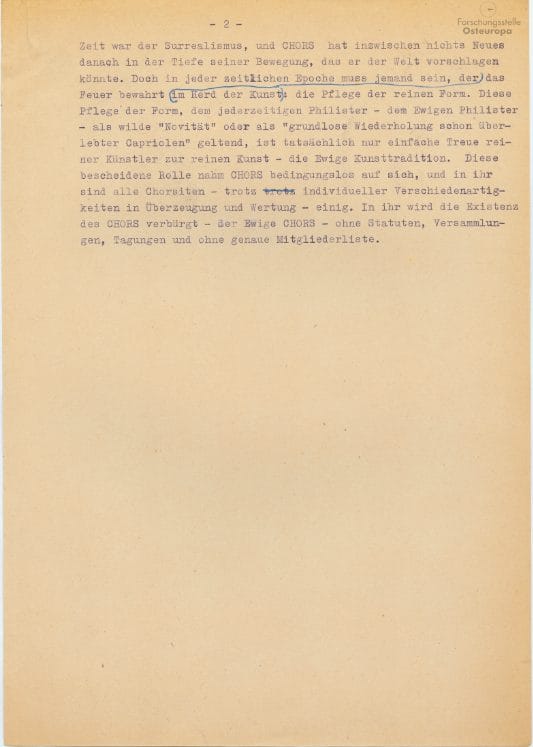
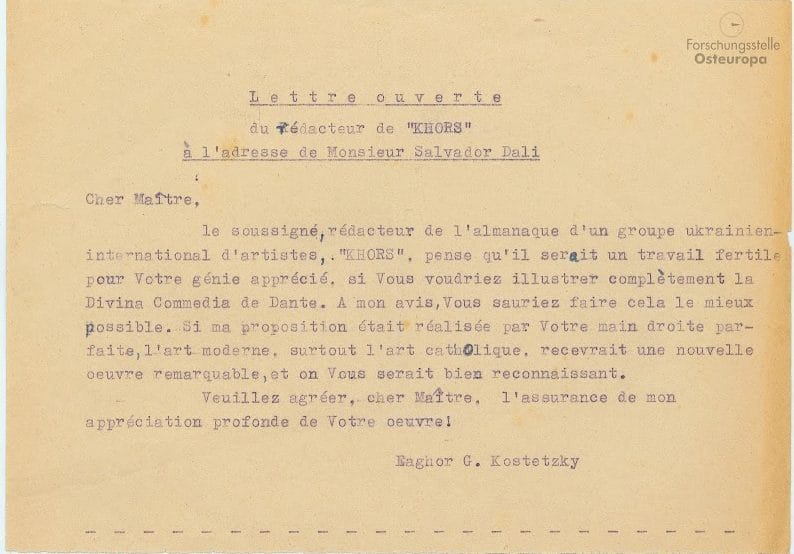

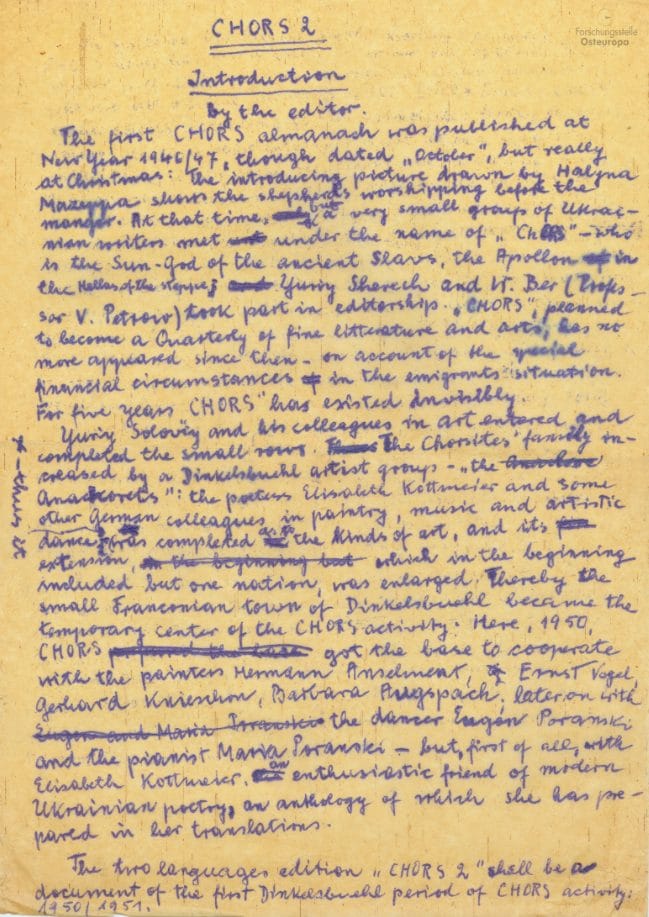
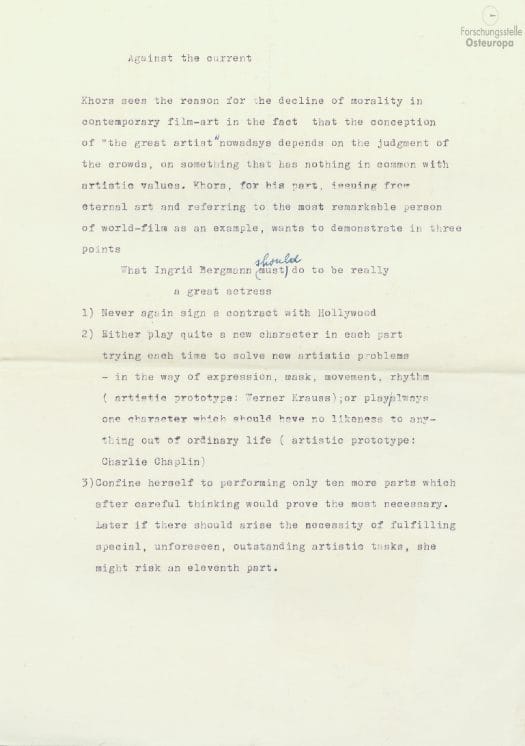
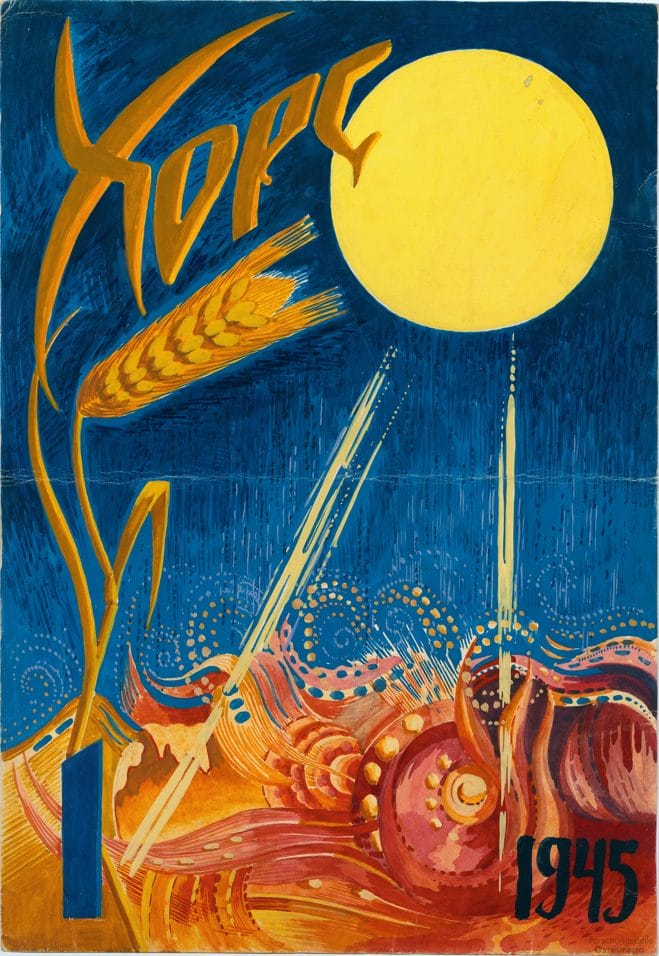
The Ukrainian DP journal KHORS focused on culture, arts, and cinema. It was published by a small team around the writer Ihor Kostetskyi. In its statutes, KHORS was not only displayed as a journal. Instead, it would be somewhat of a worldwide movement that people could join or leave, as they wish, in the future. The overriding principle was to accept the “primacy of the artistic form,” art for art’s sake. Every artist who shared these postulates was allowed to belong to KHORS “regardless of race, nationality, confessional or political convictions.” Only one group was excluded, the communists because “their ideology does not acknowledge the primacy of form.”
Kostetskyi dreamed that in the future, several groups of KHORS collectives would be formed in different parts of the world, working on different topics, having different programs and different opinions, but united by one principle – the primacy of form. With this principle, KHORS sharply opposed the Soviet way of thinking about art. In the context of socialist realism, art for art’s sake was unacceptable, as it had to serve a specific cause, such as the progress of communism. By providing a platform for Ukrainian art and artists, Kostetskyi and other compilers tried to establish contact between Ukrainian and Western cultures. For this reason, historian Marko Robert Stech believes that Kostetskyi’s efforts were an important contribution to ensuring that Ukrainian culture had a place in the world.
Despite his plans for a movement without borders and restrictions, which anyone could join or leave at will, Kostetskyi was very passionate about his project. According to Yurii Shevelov, co-editor of KHORS, Kostetskyi got angry when an author promised to publish his works in KHORS but published them elsewhere.
Kostecki wrote to Salvador Dali and asked him to illustrate Dante’s Divine Comedy for the KHORS. The letter was intended to be open and it was most likely planned to be published in a second edition dedicated to Spanish culture. However, this edition never appeared, and it is not known whether this letter got to Dali.